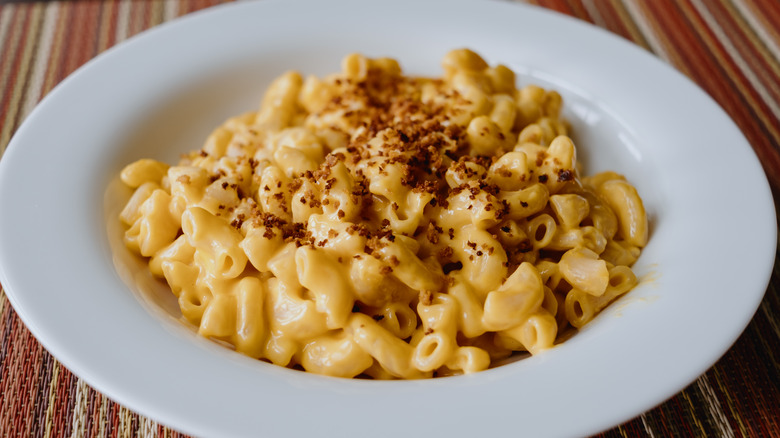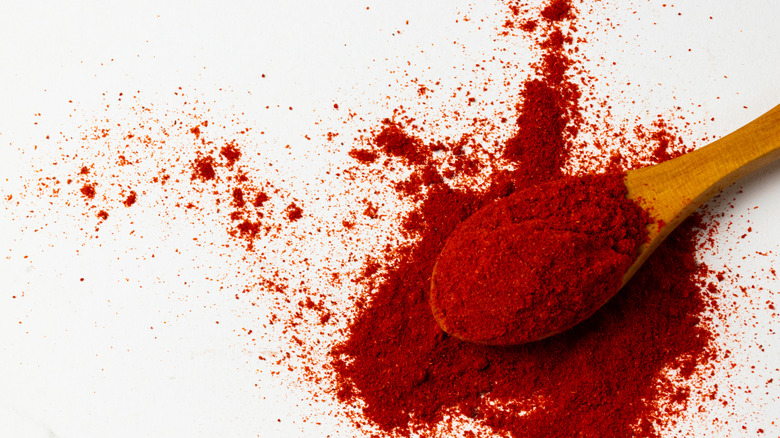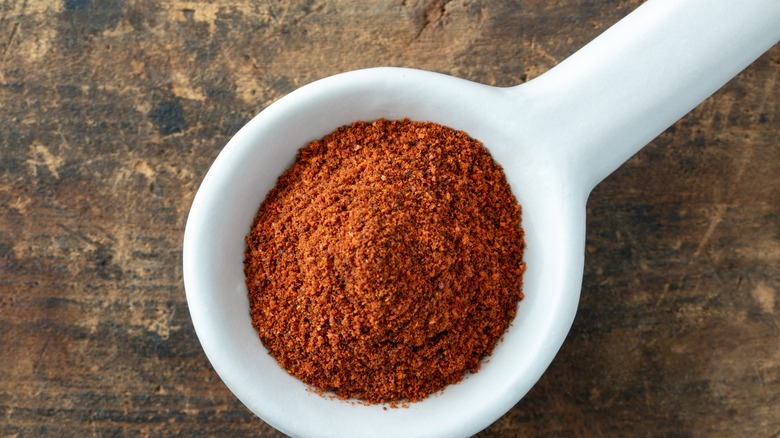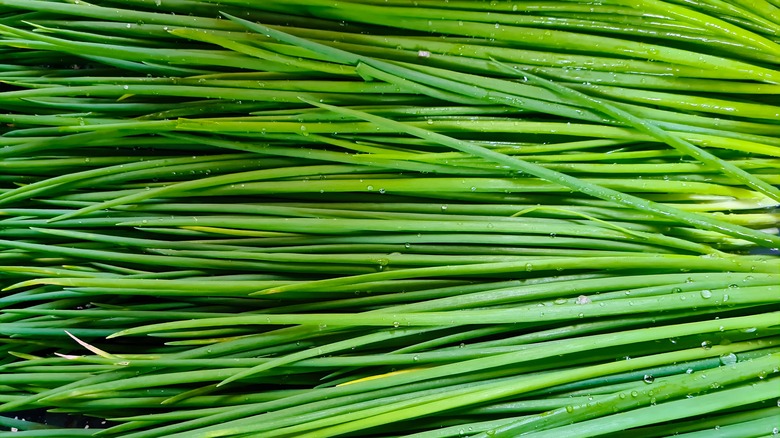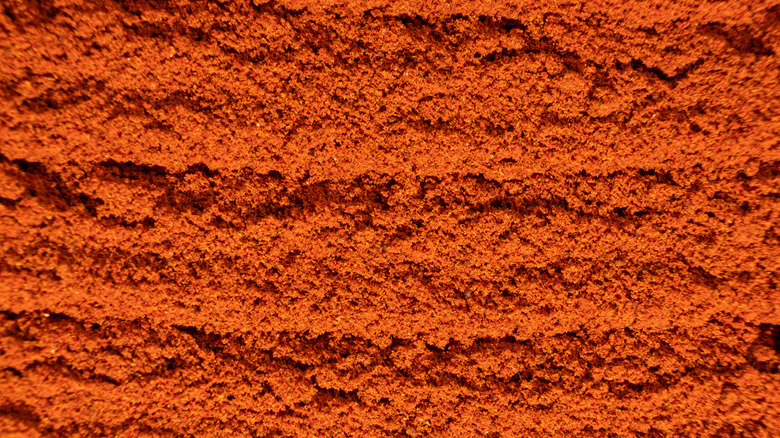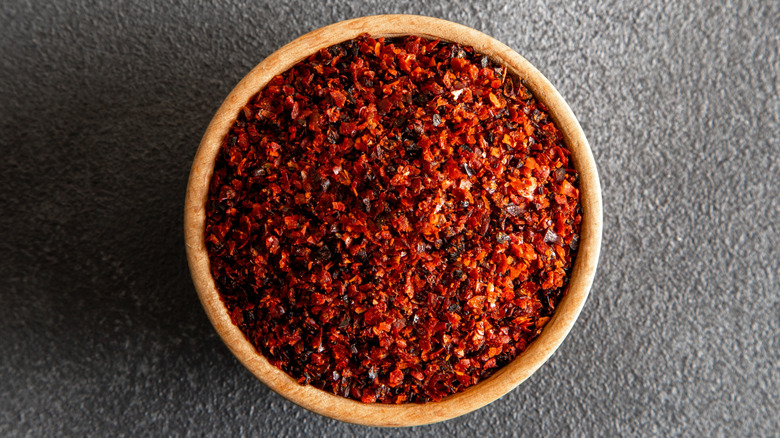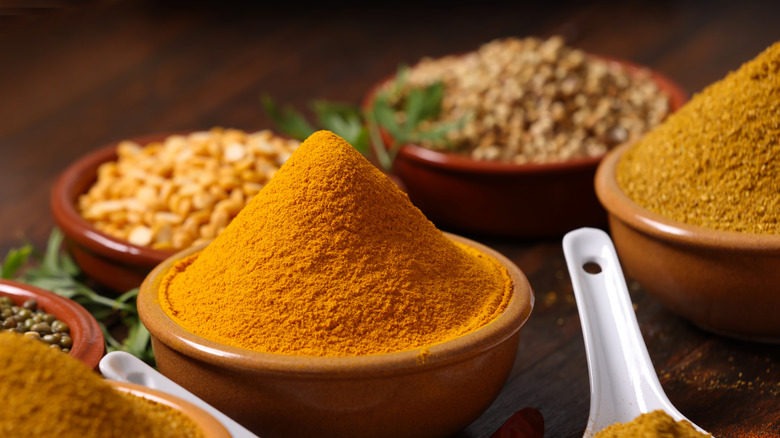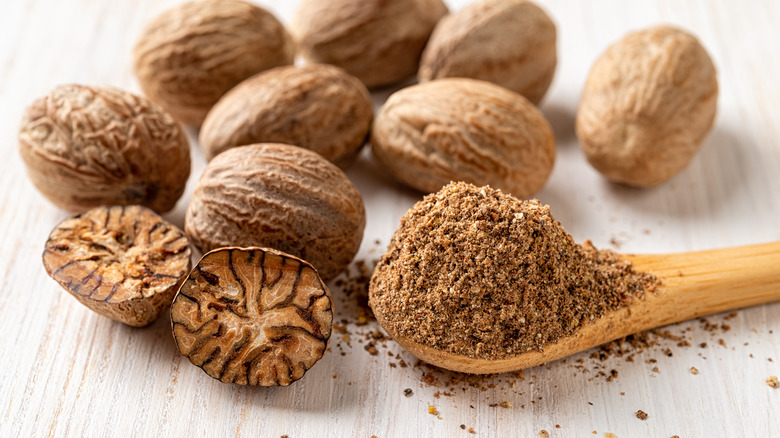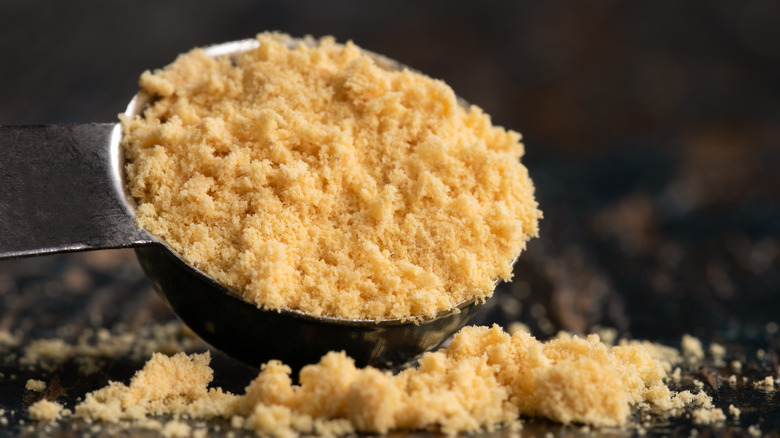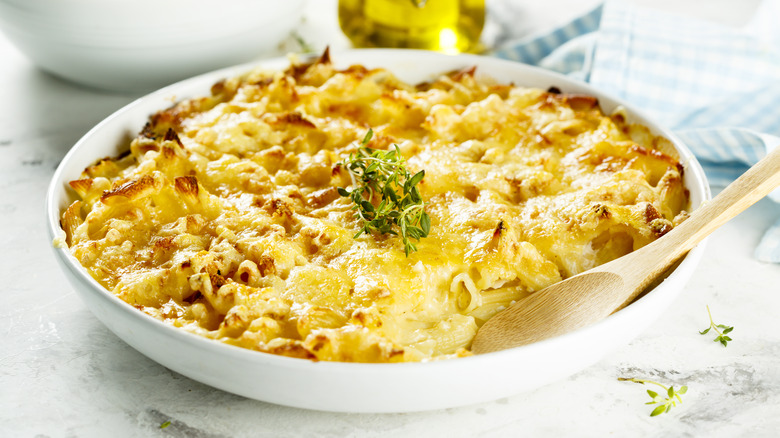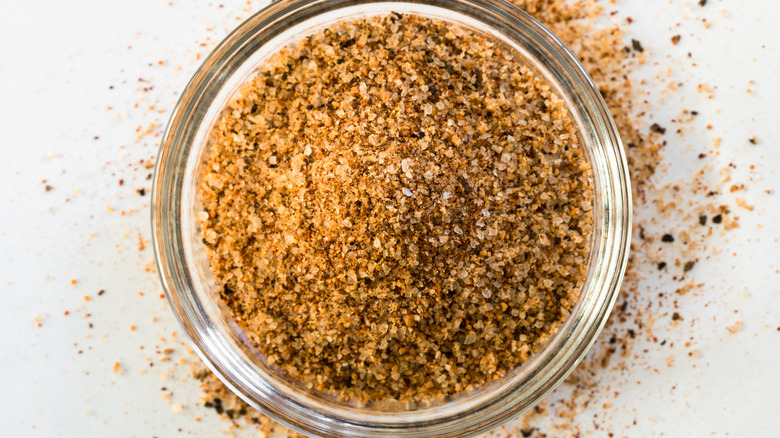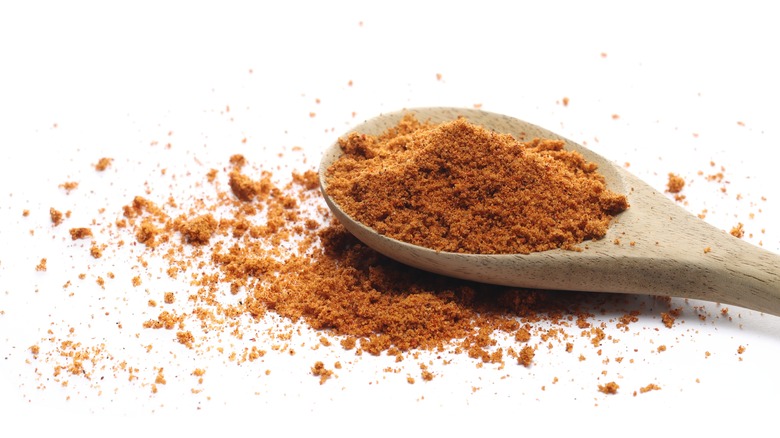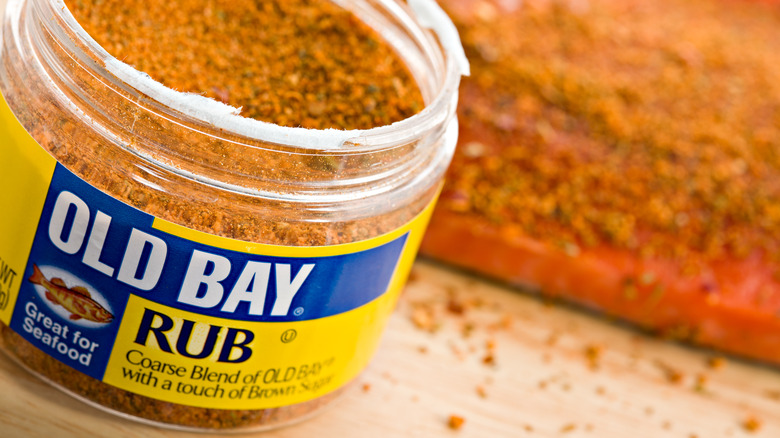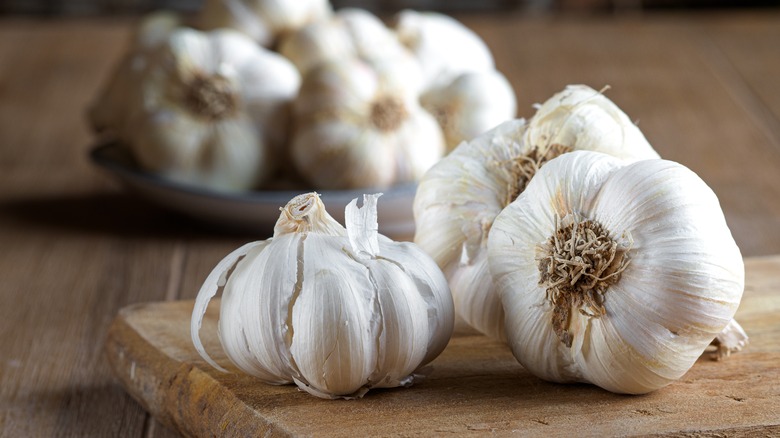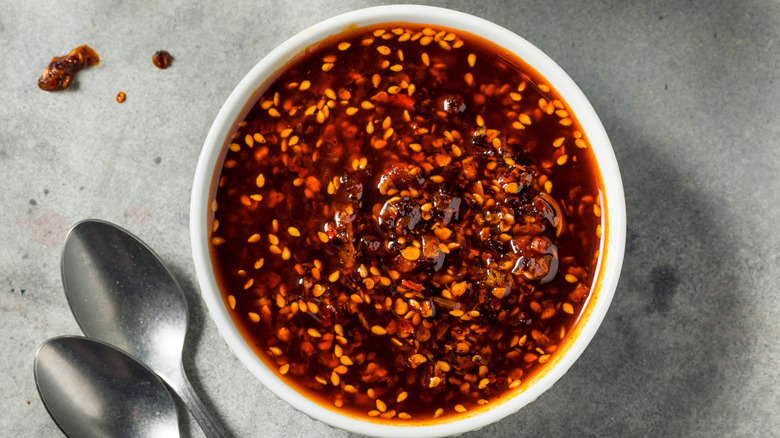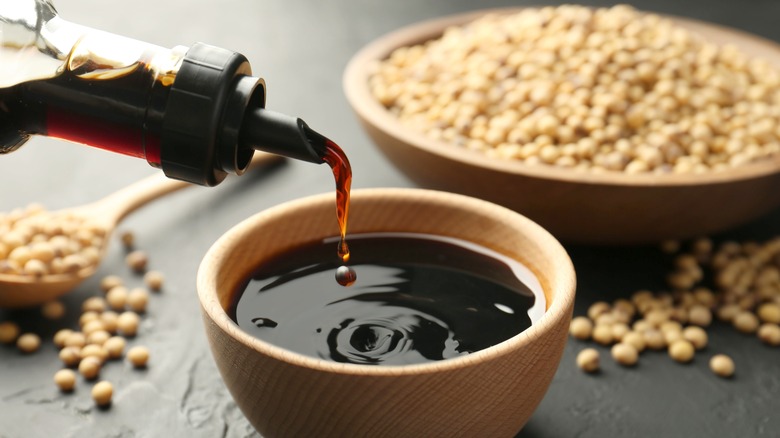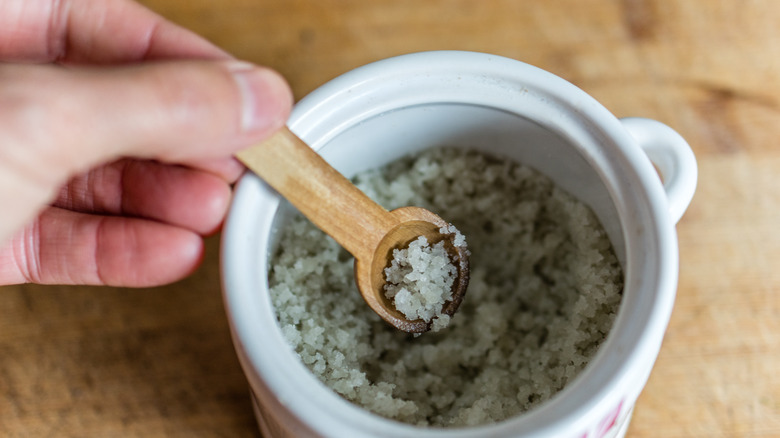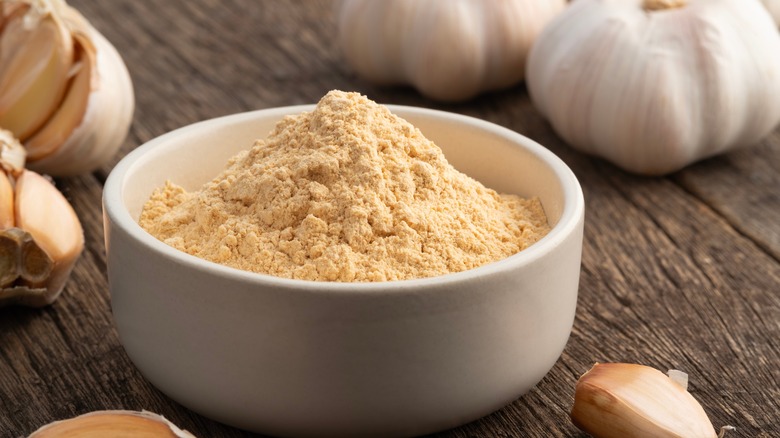The 18 Absolute Best Seasonings For Mac And Cheese
There is perhaps no meal homier and cozier than mac and cheese. Everyone seems to have their favorite recipe for this classic dish — which may or may not have been passed down from generation to generation — so much so that it can get pretty competitive when it comes down to who has the "best" one.
But what even constitutes a good mac and cheese? Well, aside from perfectly cooked noodles and a thick, decadent cheese sauce, it also comes down to its flavors. There are tons of different ways to season your mac and cheese and take it in different flavor directions, whether you're craving a mac that will sizzle on your taste buds or one that's more earthy and balanced. In order to give you some inspiration for new seasonings to try (or ones to revisit), we talked to two experts: chef and food influencer Tini Younger and Aaron Hecht, the founder of Wild West Mac & Cheese. They shared some of their favorite ways to give this timeless pasta an edge — and hopefully win you the title of "best" mac and cheese amongst family and friends.
Smoked paprika
Smoked paprika is one of the most versatile seasonings you can have in your spice rack — for mac and cheese and beyond. Unlike regular or sweet paprika, it has deeply smoky and earthy flavors that can pair well with an array of mac and cheese add-ins and cheeses.
Aaron Hecht, founder of Wild West Mac & Cheese, shares that smoked paprika is one of the spices that offers "a rich depth and just the right kick" for mac and cheese. Food influencer Tini Younger says that she is all about using smoked paprika in mac and cheese, adding, "it's kind of my go-to flavor/seasoning for anything I make."
It's easy to see why our experts love this popular spice. For one, it's in good company with other warming flavors, like cayenne and chipotle, and can be layered into your cheese sauce or breadcrumb topping to bolster the flavor of the dish. If you want to stick with the Spanish flavors, consider adding chorizo, bacon, or pancetta to your mac. It's great with a smoked gouda, since the paprika will mirror those same bold and smoky notes.
Chipotle
Chipotle is one of our favorite spices to work with, thanks to the unique smokiness it brings to a dish. We like to add it to chili, but can also see how it would be an outstanding seasoning to try in a batch of homemade mac and cheese. It's one of the seasonings that Aaron Hecht recommends adding to mac and cheese "for those who like a little fire."
There are several different ways to season your pasta dish with chipotle. The first is to add the dried powder into your cheese sauce, though you could also pick up a can of canned chipotles in adobo instead. Mince up the whole peppers and stir them into the sauce for texture and to envelop it in a rich, sweet, and tomato-forward flavor. This seasoning meshes well with ingredients that can cut through its smoky richness, like caramelized onions.
Chives
Not every ingredient you add to your mac and cheese has to be heavy. If you're looking to lighten up the mouthfeel a little bit, consider reaching for chives. This allium, which is often used as a topping for chili and baked potatoes, has a subtle, oniony bite that's a little more pared-down than what you would expect from something like a red onion or a white onion. As a result, they offer a fresher and more conservative flavor that will both elevate the flavor and color of your mac and cheese.
To preserve the chives' fresh flavor, you'll want to add them to your mac and cheese before serving it, rather than towards the beginning of the cooking process. They're a great topping for any mac and cheese ingredients that you'd also find in chili or on a baked potato, like seasoned ground beef, cheddar cheese, or hot sauce.
Cayenne pepper
Cayenne pepper is one of many ingredients that Aaron Hecht recommends adding to mac and cheese. Unlike chipotle, cayenne offers an unadulterated heat without heavy, smoky notes. It's bright, inviting, and something that spicy mac and cheese fans will absolutely adore.
This dried seasoning will cut through even the richest mac and cheese recipes, including ones made with cheddar, American, pepper Jack, and gouda. It's also flavorful enough to stand alone or alongside other equally robust spices, like dried mustard powder or garlic powder. You can add cayenne directly to your cheese sauce, or consider adding a pinch of it to your breadcrumb mixture to make a classic baked mac and cheese recipe even tastier.
Red pepper flakes
Red pepper flakes are one hot seasoning that everyone should have on hand. This spice is coarser than seasonings like cayenne and chipotle, so your next bite may be spicier than the last. If you're down for a mac and cheese that's unpredictable (in a good way), it's a must-try.
That being said, you can always concentrate the piquant flavor of the red pepper flakes by cooking them down in the fat or cheese sauce and straining them out before you stir in your pasta. Or, consider crushing the flakes with a mortar and pestle to make them finer.
Red pepper flakes offer an approachable heat and pair well with vegetable and herbs, like parsley, thyme, and chives. The herbaceous flavors bounce well off the heat and ensure each bite is balanced, rather than overwhelming.
Curry powder
One of the best parts about mac and cheese is that it works with a wide variety of seasonings. For one, Aaron Hecht suggests adding curry powder for a "fragrant, umami-packed variation" of this classic pasta dish.
The name "curry powder" can refer to an array of spice blends, which are typically tied to the Indian subcontinent. While many associate curry powder with being very spicy, there are a number of blends that are mild and accessible to even the most spice-averse of eaters. Sweet curries may contain spices like turmeric, cayenne (in a smaller concentration than a spicy curry), ginger, fenugreek, cardamom, and cloves, while hot curry powders will employ — you guessed it — hotter spices. It's a great one-stop-shop way to season your mac and cheese, though you can always add more of one ingredient if you feel like you need to.
Nutmeg
Nutmeg may be a spice that you associate more with fall, desserts, and eggnog, but it turns out that it can be a great way to upgrade mac and cheese too. Nutmeg is traditionally added to béchamel for extra warmth, so it makes sense why you would want to add it to a mac and cheese that uses béchamel as a base.
The key to adding nutmeg to mac and cheese, and to sauces in general, is that a little goes a long way. You may have even already had mac and cheese recipes that include nutmeg, but may not have even known it was in there. Even a little pinch of it will cut through the fatty richness of your dairy and cheese sauce. Stir it into your roux or cheese sauce before adding the cheese and see how it can transform even the blandest of mac recipes.
Dry mustard
Mac and cheese doesn't have to just be relegated to "kid-friendly" Kraft. If you want to make a delicious pasta dish that the adults will love, consider adding a pinch of dry mustard to your mac and cheese recipe. Dry mustard, which is not the same as the bottle of French's yellow that's hanging around in your fridge, is sharp and biting — meaning it can cut through the richness of cheddar, Gruyère, gouda, and more with ease.
Since dry mustard's flavor is so potent, you'll want to avoid being too heavy-handed with it in your recipe. The idea is to add just enough that it balances out the flavors, but not so much so that it burns your sinuses. You may not need to add more than a single teaspoon to an entire batch.
If you don't have dried mustard in your pantry, you can swap in a little Dijon mustard instead. Dijon's flavor is a little more earthy than yellow mustard, but it's delicious nonetheless and can work in a pinch.
Thyme
Thyme is such a beautiful herb, so it makes sense why you would want to add it to your mac and cheese. It's aromatic, woodsy, rich, and will bring flavor harmony to your cheesy noodles. Plus, it pairs well with rich and fatty cheeses, like Gruyère, fontina, and gouda, as well as more unconventional cheeses like Brie. You can also match it up with add-ins with similar flavor profiles, like caramelized onion, squash, and sweet potato.
Both fresh and dried thyme are fair game for your mac and cheese — though you'll want to be careful about when you add them. Dried thyme is best if it's added to the roux or cheese mixture at the beginning of the cooking process, as it will give the oils enough time to seep out and flavor the sauce, whereas fresh thyme should be reserved as a garnish.
Creole seasoning
If you want to give your mac and cheese a New Orleans twist, look no further than Creole seasoning. This unique regional blend typically contains salt, oregano, paprika, onion power, garlic powder, basil, thyme, white and black pepper, and cayenne — which come together in an aromatic and flavorful symphony. All of these spices are terrific additions to mac and cheese on their own, so why wouldn't you want to tie them all together with a bow. You can also add in other Creole-inspired ingredients, like shrimp, Andouille sausage, and even crawfish. You can add this seasoning directly to the cheese sauce, or toss it with the breadcrumbs or panko for a baked variation.
Cajun seasoning might also be up your alley if you're after something a little hotter. It focuses its attention more on the peppers than the herbs, which will give your pasta a bolder and spicier profile.
Taco seasoning
Taco seasoning is one thing that gets a ton of use in our own kitchen. It comes in packets as well as large spice containers. Once you see how delicious it can be in a mac and cheese, we're sure that you'll be adding the largest container possible to your cart on your next grocery run.
This seasoning combines all the Tex-Mex flavors you love into one place, including cumin, paprika, garlic, and onion. However, it's important to note that taco seasoning tends to come with a ton of salt — so you'll want to be careful about how you season your mac and cheese otherwise to prevent its flavor from becoming too overwhelming. Try a hearty Tex-Mex-inspired mac and cheese with ground beef, chopped peppers, jalapeños, onions, and perhaps even black beans for a hearty, fiber-packed kick. Pair it with a pepper Jack or a Mexican cheese blend for a tasty weeknight meal that transforms taco Tuesday into something more unique.
Old Bay seasoning
If you live in the Chesapeake region, you are probably no stranger to Old Bay seasoning. This spice blend, which is a proprietary (and secret) spice medley that includes cinnamon, paprika, cloves, nutmeg, celery salt, and black and red pepper, is one of Tini Younger's favorite ingredients to add to mac and cheese.
Old Bay seasoning is often used for seafood-inspired recipes, as its blend of herbs and spices can cut through salty seafood with ease. As such, it would be a stellar addition to a seafood mac and cheese, like one made with lump crab meat, shrimp, and/or lobster. You may also want to consider adding in a little bacon, pancetta, or even Andouille sausage for a fattier bite that will mesh well with the seasoning's aromatic components.
Hot sauce
Preparing mac and cheese for a potluck can be difficult, as everyone's version of the "perfect mac and cheese" is different. For example, if you're feeding folks who are spice averse, you may not want to add too many spicy components to your mac. The better alternative is to make a standard batch of the dish, then serve it with an array of hot sauces so your guests can drizzle it on at their leisure. You can find hot sauces that are burn-your-mouth-spicy, as well as those that have a stronger smoky component, which would work well with cheese sauces seasoned with chipotle and/or smoked paprika.
The other benefit of seasoning your mac with hot sauce is that you can dress it up or down depending on the occasion. While a classic mac with a coating of your favorite hot sauce is always a good move, so is Aaron Hecht's recommendation: an Asian-inspired mac and cheese, loaded with crispy pork belly, soy sauce, Thai chiles, and topped with a drizzle of sriracha.
Fresh garlic
Garlic is a basic, yet worthwhile addition to almost any savory dish — including mac and cheese. It's biting, pungent, and will offer the perfect flavor contrast to the rich cheese and other seasonings. Tini Younger shares that she likes to add fresh garlic to her truffle mac and cheese, but that's not to say you can't add it to your favorite homestyle recipe too.
Interestingly enough, the size you chop your garlic will dictate how much its flavor comes through. If you want to only add a slightly garlicky undertone, use large pieces of garlic and then remove them before you stir in the pasta. On the other hand, if you want the garlic flavor front and center, mince it up as finely as possible.
Another way to alter garlic's flavor is to either roast it or use cured black garlic instead. Both of these have a milder, almost caramelized flavor that would complement everything from gouda to Gruyère.
Chili crisp
Chili crisp is an excellent condiment to have on hand, and it turns out that it's also one of the secret ingredients Aaron Hecht recommends for a fiery yet cozy bowl of mac and cheese. As its name suggests, it includes crispy bits — often a medley of chile peppers, Sichuan peppercorns, and aromatics — preserved in oil. Its predominant flavor is hot and spicy, though different chefs and companies will use different ratios of ingredients, thus producing crisps that are more aromatic or spicier than others.
You can drizzle some of the condiment on top to upgrade the texture and flavor of your mac and cheese. Though, it can also be integrated into the cheese sauce so that its flavor can disperse throughout the dish.
Soy sauce
Soy sauce might sound like an unexpected addition to mac and cheese, but it truly can be a home run combo — at least according to Aaron Hecht. "The creaminess of the cheese works surprisingly well with bold, savory Asian flavors," he says.
This condiment is not only an excellent replacement for the regular salt in your recipe, but it has more intense flavor notes than just "salty." The umami profile will mesh well with an array of cheeses, as well as other Asian-inspired flavors, like Thai chiles and curry powder, per Hecht's recommendation. Soy sauce's flavor tends to be very concentrated though, so just make sure not to be too heavy-handed with your pour.
Seasoned salt
"Seasoned salt" casts a wide net and includes everything from truffle salt to Lawry's seasoning. In essence, it's like salt with extra perks — and those perks allow you to easily customize the flavor of your mac and cheese without too much work required on your part.
Seasoned salt is an excellent alternative to regular salt alone and it would be an ideal addition for someone who doesn't have an expansive spice selection to choose from. You can enhance the aromatic, warming, and herbal qualities of your mac just by selecting the right seasoned salt. Just be sure to omit or cut back on other salty additions — like table salt and bacon — to ensure that you don't end up over-salting your sauce.
Garlic and onion powder
Not everyone has fresh garlic and onions lying around at all times, which is where the powdered versions of these two popular seasonings come into play. "I have done fresh garlic, but I prefer the powder when it comes to mac and cheese," says Tini Younger. The benefits of using the powder are numerous, and include a longer shelf-life and better dispersal into the sauce than the fresh stuff. You also don't have to saute the garlic and onion ahead of time, which can help you cut down on your prep time.
Aaron Hecht recommends trying an Italian spin on a classic mac and cheese by pairing both garlic and onion powder with Parmesan, spicy Italian sausage, and roasted broccoli. As he says, it's a "hearty and herbaceous twist that feels like Sunday supper with a rebellious edge."
